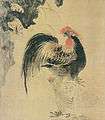Jang Seung-eop
Jang Seung-eop (1843–1897) (commonly known by his pen name Owon) was a painter of the late Joseon Dynasty in Korea. His life was dramatized in the award-winning 2002 film Chi-hwa-seon directed by Im Kwon-taek. He was one of the few painters to hold a position of rank in the Joseon court.
| Jang Seung-eop | |
| Hangul | 장승업 |
|---|---|
| Hanja | 張承業 |
| Revised Romanization | Jang Seung-eop |
| McCune–Reischauer | Chang Sŭngŏp |
| Pen name | |
| Hangul | 오원 |
| Hanja | 吾園 |
| Revised Romanization | Owon |
| McCune–Reischauer | Owŏn |
| Courtesy name | |
| Hangul | 경유 |
| Hanja | 景猶 |
| Revised Romanization | Gyeong-yu |
| McCune–Reischauer | Kyŏngyu |
Biography
Growing up as an orphan, Owon learned painting while staying at another family's house. He first had the opportunity to paint extensively when he was taken into the household of aristocrat Yi Ung-heon in his 20s. Later, his talent became widely known, and he painted extensively in all genres of the time, including landscapes, flower paintings, and paintings of daily life.
Together with the earlier painters Danwon and Hyewon, Owon is remembered today as one of the "Three Wons" of Joseon-period painting.
Gallery
 Samin munnyeondo
Samin munnyeondo Hochwido
Hochwido Painting of a cat by Owon
Painting of a cat by Owon Sansu inmuldo means "the picture of a man in the landscape"
Sansu inmuldo means "the picture of a man in the landscape" Rooster
Rooster Ssangma inmuldo (the painting of a man with two horses)
Ssangma inmuldo (the painting of a man with two horses) Chowon jirok
Chowon jirok
See also
| Wikimedia Commons has media related to Jang Seung-eop. |
- Korean art
- Korean culture
- Korean painting
- List of Korea-related topics
- List of Korean painters